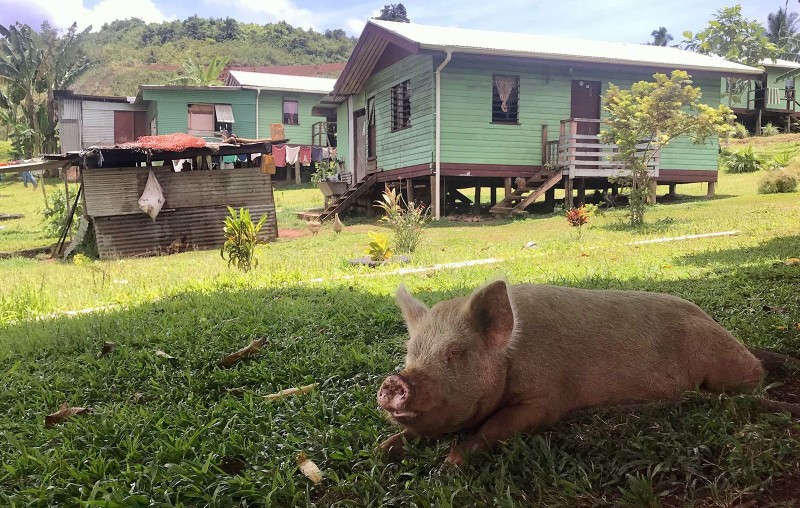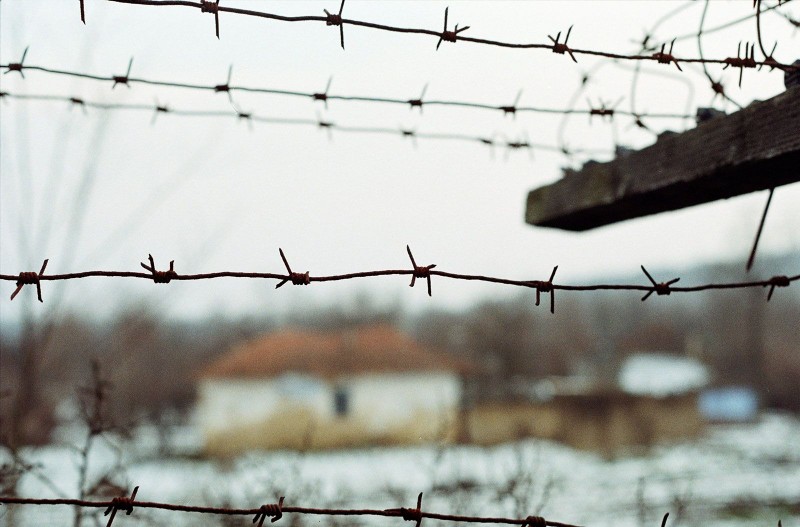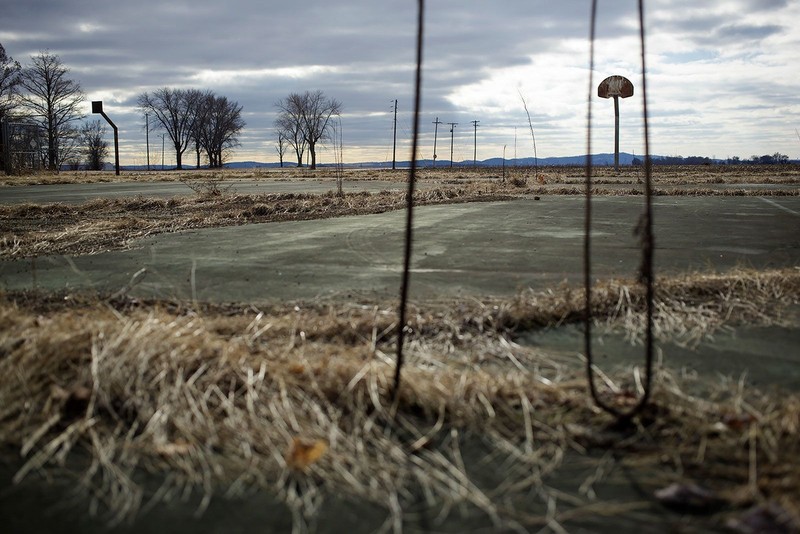When natural resources of a depleted land, the source of life no longer exists, people will leave. All that remains is desolation, dust and oblivion.
But over time, when the natural ecosystem revived, people found there a new prospect of exploitation. So a new reclamation began, economic development pulled everything back to life.
It is a natural cycle of lands, birth then death and birth again, so we often take pride in Earth its vastness, that it is home to nearly 8 billion people and could be home to many billions more, forever.
| Isle de Jean Charles, in Terrebonne, Louisiana (USA), is gradually “disappearing”. |
However, there is a truth that, these “ghost” land on our planet more and more. And what is worth mentioning is that they cannot repeat that cycle of revival anymore, because the destructive power of nature has destroyed them.
Climate change with increasing severity has brought countless natural disasters such as storms, floods, droughts, forest fires… They have, are and will wipe out many things, including lands.
In her book The Nomadic Century: How Climate Change Migration Will Reshape Our World, author Gaia Vince writes: “We will see a movement – it is already happening. out – where people are moving, forcibly, from areas severely affected by storms, rising sea levels, floods and constant fires.
They will leave without being able to return, that is inevitable. How many people want to return to live in Lahaina, Hawaii after the fire there? Besides some people who cannot go due to force majeure reasons, for the rest, I think they will go and never return. Giving up their homeland and familiar place of living is often the last scenario that people think of when they have no other choice.”
Jack DeWaard, science director of the Population Council, an international non-governmental organization, and an expert on environmental and climate-related migration, said: “For migrants, preparation is important. Costs, psychology and planning for economic stability in the new place of residence are very important.
“They were forced to leave their traditions, their family and friend relationships, their ancestral graves, even their language, just because the land on which they were located became uninhabitable. This It’s really a big pain.”
According to United Nations statistics, more than 20 million people are forced to leave their homes due to extreme weather each year. Researchers predict that by the end of this century, about 3 to 6 billion people will be outside the “human climate niche” (this is the climate zone suitable for humans to live in). can sustain daily life, determined by calculating the ratio of population density to average annual temperature).
According to this prediction, “it does not mean that 3 to 6 billion of us will have to migrate, but it just means that many more people will be forced to move from their homeland to a new land, because climate,” Gaia Vince writes in her book.
“This will impact communities of color and those facing poverty. Often, migration and displacement, are processes rooted in inequality, crisis climate will exacerbate existing inequalities,” DeWaard explains.
Below are typical examples of “ghost lands” in the world, they are created by climate change and can be a harbinger for the future of many other lands.
Vunidogoloa, Fiji
Located in the South Pacific, the island nation of Fiji is particularly vulnerable to the impacts of climate change due to rising sea levels and increasingly frequent cyclones with increasing intensity.
 |
| Fiji’s Vunidogoloa town. |
Dozens of coastal communities in Fiji have been planned by the government to relocate to higher ground, when the risk of being wiped out by sea water is closer than ever.
Among them is Vunidogoloa, a small village on Vanua Levu, the country’s second largest island, which was the first to be relocated to the hillside area in 2014.
However, today, this village of more than 150 people has become a desolate place. The ruins are now covered by an extensive vegetation.
Đảo Isle by Jean Charle, Louisiana
Communities living along the Louisiana coast are already being devastated by the impacts of sea level rise, coastal erosion, storms and hurricanes caused by climate change.
Among them is Isle de Jean Charles, an island in the Gulf of Mexico about 129 km south of New Orleans. This place once had an area of nearly 9,000 hectares, but today, the island is gradually sinking, leaving only about 129 hectares of land area.
The community has received a government grant for the purpose of developing a new settlement called “The New Isle” located about 40 miles north of Isle de Jean Charles, on a higher ground. As of October 2023, all residents of Isle de Jean Charles have moved there, except for four households who have chosen to remain.
Cotul Morii, Moldova
Among the countries most vulnerable to climate change in Europe, Moldova is facing many ongoing climate risks such as heat waves, storms, droughts and, most notably, floods. floods, this small country has recorded three major floods in the past 20 years.
 |
| Cotul Morii, a village on the banks of the Prut River. |
The impact of the flood has caused serious damage to a country where agriculture accounts for a large part of the economy. Not only that, many residential areas are said to be devastated to the point of being unable to survive. can fix it. One of them is Cotul Morii, a village on the banks of the Prut River, which was submerged by a catastrophic flood in 2010.
Instead of restoring the population after the flood, the government chose to relocate the village of Cotul Morii to an area about 9 miles away.
Chacaltaya Ski Resort, Bolivia
Opened in the 1930s, Chacaltaya Ski is the most famous and only ski resort in the Bolivian Andes. Not only that, located on the top of Chacaltaya mountain, it is also considered the highest ski area in the world.
For decades, Chacaltaya Ski became a popular destination for ski lovers until it was forced to close in 2009. That was also the year the 18,000-year-old Chacaltaya glacier completely melted due to climate change. climate change. Along with that, a large patch of snow completely disappeared.
Today, the once famous resort with its cafes, bars and ski lifts has been abandoned, becoming a testament to what happened.
Valmeyer, Illinois (Chicago, Mỹ)
Climate change has increased the cycle of droughts and floods along the Mississippi River, North America’s longest river, making weather forecasting difficult and inaccurate.
 |
| The old basketball court at Valmeyer High School is abandoned. |
In 1993, a major flood flooded the small town of Valmeyer, Illinois – the state of Chicago, USA, damaging most of the buildings here. The town’s residents – with the support of the government – decided to plans to rebuild his town in a neighboring area.
Although this flooding event probably occurred before climate change became apparent, 30 years later, the town of Valmeyer is considered a case study in regional resettlement. population to cope with the increasingly harsh climate.
“Black tourism” – a tourism solution to raise awareness of “saving” “ghost” lands
Developing “ghost” towns or abandoned villages into tourist destinations is no longer a strange way to restore the economy.
But in lands devastated by natural disasters, no one wants to be suddenly evacuated during their vacation due to forest fires, storms or floods.
And then, “from the difficult to the wise”, people came up with a method that is to develop “black tourism”.
What is it?
Philip Stone, Director of the “Black Tourism” Development Research Institute at the University of Central Lancashire, UK, explains that “Black” here means death, disaster and the horrifying destruction of lands. but natural disasters pass.
The purpose of this solution is to, through witnessing destroyed lands, raise tourists’ awareness of the remnants of climate change, in which we, humanity, have contributed. very large part.
“The visual impact of the devastated landscape caused by climate change serves as a warning about our industrialization,” says Philip Stone. “Visiting such places provides an educational experience for visitors.”

